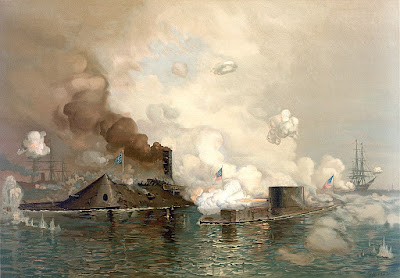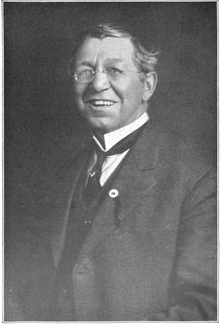March 9, 1862: The Battle of Hampton Roads ends in a Union victory
At the beginning of the Civil War, the Union had a clear naval advantage. The Confederate navy was almost nonexistent. The Confederate Secretary of the Navy, Stephen Mallory sought to change that. Throughout the 1850's, European countries experimented with ships made out of iron that ran on steam power. The new technology was miles ahead of the old wooden ships left over from the 18th century. Confederate naval experts realized that these ships would give them a chance against the Union navy, currently blockading every major southern port.
The C.S.S. Virginia began to be built in the fall of 1861. The body of the ship was reconstruction from the husk of the sunken Union ship, U.S.S. Merrimack. The ship was refurbished with iron plating, new guns, and an iron ram. The ship was completed in February of 1862. In early March, the Virginia was launched and began to creep down the coast toward the unsuspecting Union blockade.
 Reports of the Virginia's construction has reached the Union Secretary of the Navy, Gideon Welles in the fall of 1861. Welles sought out Swedish inventor, John Ericsson to build a similar ship. Ericsson's design was similar to the Virginia with one major difference. He installed a rotary turret to house the ship's massive guns. The U.S.S. Monitor took to the seas a few days after the Confederates launched the Virginia. The Monitor traveled down the East Coast to a fateful encounter with the Virginia.
Reports of the Virginia's construction has reached the Union Secretary of the Navy, Gideon Welles in the fall of 1861. Welles sought out Swedish inventor, John Ericsson to build a similar ship. Ericsson's design was similar to the Virginia with one major difference. He installed a rotary turret to house the ship's massive guns. The U.S.S. Monitor took to the seas a few days after the Confederates launched the Virginia. The Monitor traveled down the East Coast to a fateful encounter with the Virginia.
 On the morning of March 8, sailors aboard the blockade ship, U.S.S. Cumberland reported seeing a dark shape skimming slowly across the water. The dark mass headed directly at the Cumberland. As it came into the sailor's view, it was already on top them. The Virginia rammed a giant hole into the Cumberland's bow, paralyzing the ship. The Union ships, U.S.S. St. Lawrence, Roanoke, Minnesota, and Brandywine came to the Cumberland's aid but by late morning, all but one were sunk. As day turned to night, the Virginia torn through the Union blockade to pieces. The Virginia would have been successful in destroying that part of the blockade, if it had not withdrawn due to lack of visibility. March 9 was a bright and clear day, perfect for the Virginia to resume its attack. However as the ship emerge from the sound it was struck with a shot. The Monitor had arrived into the roads. The shots from the Monitor harmlessly bounced off the Virginia's hull. The Virginia returned fire but the shots had the same effect on the Monitor. The exchange continued for hours, until a stray shot destroyed the Monitor's pilot house. All seemed lost, but once again the Virginia began to withdraw. The overwhelmed Confederates did not want to possibly lose their strongest naval asset. The Union declared the battle a victory.
On the morning of March 8, sailors aboard the blockade ship, U.S.S. Cumberland reported seeing a dark shape skimming slowly across the water. The dark mass headed directly at the Cumberland. As it came into the sailor's view, it was already on top them. The Virginia rammed a giant hole into the Cumberland's bow, paralyzing the ship. The Union ships, U.S.S. St. Lawrence, Roanoke, Minnesota, and Brandywine came to the Cumberland's aid but by late morning, all but one were sunk. As day turned to night, the Virginia torn through the Union blockade to pieces. The Virginia would have been successful in destroying that part of the blockade, if it had not withdrawn due to lack of visibility. March 9 was a bright and clear day, perfect for the Virginia to resume its attack. However as the ship emerge from the sound it was struck with a shot. The Monitor had arrived into the roads. The shots from the Monitor harmlessly bounced off the Virginia's hull. The Virginia returned fire but the shots had the same effect on the Monitor. The exchange continued for hours, until a stray shot destroyed the Monitor's pilot house. All seemed lost, but once again the Virginia began to withdraw. The overwhelmed Confederates did not want to possibly lose their strongest naval asset. The Union declared the battle a victory.
The clash of ironclads made the other navy's of the world obsolete overnight. Even though the ships produced a clear advantage to both sides, they would not survive the war. As the Virginia retreated upriver, it became embedded in the riverbed. Unable to release it, the Confederates blew the Virginia up, in order to prevent the Union from capturing it. The Monitor met its end soon after. After the battle, the ship was put on blockade duty. As it was being towed back for repairs on New Years' Eve of 1862, it began to take on water. In the early hours of December 31, it sank to the bottom of the ocean.
The C.S.S. Virginia began to be built in the fall of 1861. The body of the ship was reconstruction from the husk of the sunken Union ship, U.S.S. Merrimack. The ship was refurbished with iron plating, new guns, and an iron ram. The ship was completed in February of 1862. In early March, the Virginia was launched and began to creep down the coast toward the unsuspecting Union blockade.
 Reports of the Virginia's construction has reached the Union Secretary of the Navy, Gideon Welles in the fall of 1861. Welles sought out Swedish inventor, John Ericsson to build a similar ship. Ericsson's design was similar to the Virginia with one major difference. He installed a rotary turret to house the ship's massive guns. The U.S.S. Monitor took to the seas a few days after the Confederates launched the Virginia. The Monitor traveled down the East Coast to a fateful encounter with the Virginia.
Reports of the Virginia's construction has reached the Union Secretary of the Navy, Gideon Welles in the fall of 1861. Welles sought out Swedish inventor, John Ericsson to build a similar ship. Ericsson's design was similar to the Virginia with one major difference. He installed a rotary turret to house the ship's massive guns. The U.S.S. Monitor took to the seas a few days after the Confederates launched the Virginia. The Monitor traveled down the East Coast to a fateful encounter with the Virginia. On the morning of March 8, sailors aboard the blockade ship, U.S.S. Cumberland reported seeing a dark shape skimming slowly across the water. The dark mass headed directly at the Cumberland. As it came into the sailor's view, it was already on top them. The Virginia rammed a giant hole into the Cumberland's bow, paralyzing the ship. The Union ships, U.S.S. St. Lawrence, Roanoke, Minnesota, and Brandywine came to the Cumberland's aid but by late morning, all but one were sunk. As day turned to night, the Virginia torn through the Union blockade to pieces. The Virginia would have been successful in destroying that part of the blockade, if it had not withdrawn due to lack of visibility. March 9 was a bright and clear day, perfect for the Virginia to resume its attack. However as the ship emerge from the sound it was struck with a shot. The Monitor had arrived into the roads. The shots from the Monitor harmlessly bounced off the Virginia's hull. The Virginia returned fire but the shots had the same effect on the Monitor. The exchange continued for hours, until a stray shot destroyed the Monitor's pilot house. All seemed lost, but once again the Virginia began to withdraw. The overwhelmed Confederates did not want to possibly lose their strongest naval asset. The Union declared the battle a victory.
On the morning of March 8, sailors aboard the blockade ship, U.S.S. Cumberland reported seeing a dark shape skimming slowly across the water. The dark mass headed directly at the Cumberland. As it came into the sailor's view, it was already on top them. The Virginia rammed a giant hole into the Cumberland's bow, paralyzing the ship. The Union ships, U.S.S. St. Lawrence, Roanoke, Minnesota, and Brandywine came to the Cumberland's aid but by late morning, all but one were sunk. As day turned to night, the Virginia torn through the Union blockade to pieces. The Virginia would have been successful in destroying that part of the blockade, if it had not withdrawn due to lack of visibility. March 9 was a bright and clear day, perfect for the Virginia to resume its attack. However as the ship emerge from the sound it was struck with a shot. The Monitor had arrived into the roads. The shots from the Monitor harmlessly bounced off the Virginia's hull. The Virginia returned fire but the shots had the same effect on the Monitor. The exchange continued for hours, until a stray shot destroyed the Monitor's pilot house. All seemed lost, but once again the Virginia began to withdraw. The overwhelmed Confederates did not want to possibly lose their strongest naval asset. The Union declared the battle a victory.The clash of ironclads made the other navy's of the world obsolete overnight. Even though the ships produced a clear advantage to both sides, they would not survive the war. As the Virginia retreated upriver, it became embedded in the riverbed. Unable to release it, the Confederates blew the Virginia up, in order to prevent the Union from capturing it. The Monitor met its end soon after. After the battle, the ship was put on blockade duty. As it was being towed back for repairs on New Years' Eve of 1862, it began to take on water. In the early hours of December 31, it sank to the bottom of the ocean.





Comments
Post a Comment